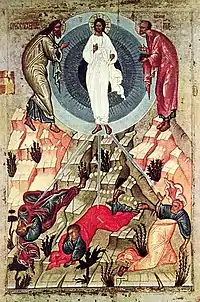Friends of God
The Friends of God (German: Gottesfreunde; or gotesvriunde) was a medieval mystical group of both ecclesiastical and lay persons[1] within the Catholic Church (though it nearly became a separate sect) and a center of German mysticism. It was founded between 1339 and 1343 during the Avignon Papacy of the Western Schism, a time of great turmoil for the Catholic Church. The Friends of God were originally centered in Basel, Switzerland and were also fairly important in Strasbourg and Cologne. Some late-nineteenth century writers made large claims for the movement, seeing it both as influential in fourteenth-century mysticism and as a precursor of the Protestant Reformation. Modern studies of the movement, however, have emphasised the derivative and often second-rate character of its mystical literature, and its limited impact on medieval literature in Germany.[2]
| Part of a series on |
| Christian mysticism |
|---|
 |
Name
The name "Friends of God" may have been influenced by various sources. A number of biblical passages use the term (e.g. Judges 8.22, James 2.23, Exodus 33.11, Psalm 138.17, Wisdom 7.27, Lk 12.4, John 15.15) The concept of friendship with God had also been applied by various medieval authors, and particularly among Meister Eckhart and his followers.[2]
History
The movement grew out of the preaching and teaching of Meister Eckhart, and especially his Dominican spiritual heirs the preacher John Tauler and the writer Henry Suso. An influence on the Friends of God, although remaining in the background, was the secular priest Henry of Nördlingen,[3] from the Bavarian Oberland, who met Tauler and Suso in Basel in 1339. Henry had a great deal of interaction with other Bavarian and German mystics[4] and introduced the Friends of God to The Flowing Light of the Deity by Mechthild of Magdeburg.
The group achieved a nascent institutional form in 1367 when wealthy layman Rulman Merswin purchased and restored a derelict monastery in Strasbourg known as the grünenwörth ('Green Isle').[5] Grünenwörth served as a refuge for study for the Friends of God and as a “school of prophets” which produced a number of mystical texts.[6] Merswin is suspected of being the anonymous author The Friend of God from the Oberland.[7]
The Friends of God, as led by Tauler and Suso, sought a mystical path in line with established Catholic doctrine, following Thomas Aquinas. Rulman Merswin, under the guidance of The Friend of God from the Oberland, wanted to purify the Church. This stress on reform brought The Friends of God into conflict with the Church and not long after Merswin’s death in 1382, they were condemned.[1]
After Merswin's death, some sources claim that Nicholas of Basel became the leader. He was eventually burned at the stake with two of his followers for heresy at Vienna around 1395.[8] The relationship of Nicholas of Basel to the Friends of God is unclear as he was condemned as a Beghard.[9]
Another prominent member, Martin of Mainz, a follower of Nicholas of Basel, was also burned for heresy in 1393.[9]
Texts
A number of mystical texts are associated with The Friends of God, most notably the Theologia Germanica and the Book of the Nine Rocks. Many of the works were attributed to The Friend of God from the Oberland, although probably written by Rulman Merswin himself.[6]
References
- Walsh, Reginald. "Friends of God." The Catholic Encyclopedia Vol. 6. New York: Robert Appleton Company, 1909. 6 December 2017
- McGinn, Bernard. The Harvest of Mysticism, (2005), p408.
- Dictionary of German Biography Volume 8, Walther Killy et al., eds; K G Saur Verlag Gmbh & Co; Reprint 2011 ed. Edition p. 493
- Catholic Encyclopedia
- McGinn, p. 417.
- Jones, Rufus M., Studies in Mystical Religion, Eugene, OR: Wipf and Stock, no date pp. 247-252 (originally published London: Macmillan, 1909)
- Weeks, Andrew. German Mysticism From Hildegard of Bingen to Ludwig Wittgenstein, SUNY Press, 1993, p. 94, ISBN 9780791414194
- "Nicholas of Basel", BrillOnLine
- Leff, Gordon. Heresy in the Later Middle Ages: The Relation of Heterodoxy to Dissent, c. 1250 – c. 1450, Manchester: Manchester University Press, 1967 (reprinted by Sandpiper Book, 1999), p. 383
![]() This article incorporates text from a publication now in the public domain: Herbermann, Charles, ed. (1913). "Friends of God". Catholic Encyclopedia. New York: Robert Appleton Company.
This article incorporates text from a publication now in the public domain: Herbermann, Charles, ed. (1913). "Friends of God". Catholic Encyclopedia. New York: Robert Appleton Company.
Further reading
- Rufus M. Jones, Studies in Mystical Religion, Eugene, OR: Wipf and Stock, no date (originally published London: Macmillan, 1909)
- Gordon Leff, Heresy in the Later Middle Ages: The Relation of Heterodoxy to Dissent, c. 1250 – c. 1450, Manchester: Manchester University Press, 1967 (reprinted by Sandpiper Book, 1999)
- Bernard McGinn, The Harvest of Mysticism in Medieval Germany (The Presence of God Volume 4), The Crossroad Publishing Company (2005)